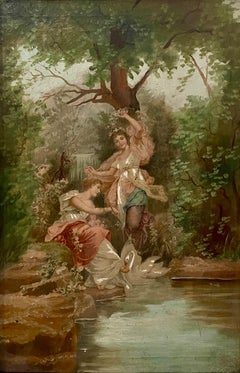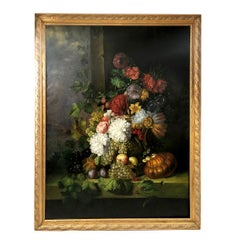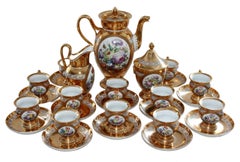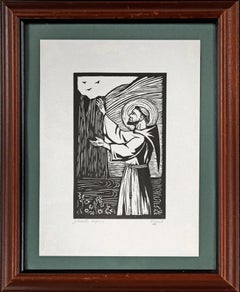Baroque Art
3
to
10
20
12
8
6
15
8
9
4
11
4
4
Overall Height
to
Overall Width
to
36,040
19,578
14,632
8,937
7,223
5,218
3,443
2,383
1,900
974
576
429
102
93
25
15
11
7
7
4
3
3
3
2
2
2
2
2
1
1
1
1
1
1
260
51
32
119
2
3
5
2
4
1
3
2
84
1
1
1
1
12
11
7
7
4
Style: Baroque
Period: 20th Century
Jules Gouillet, Architectural and Floral Composition, Oil on Canvas, 1907
Located in Saint Amans des cots, FR
Oil on canvas by Jules Gouillet (1826-), France, 1907. Architectural and floral composition. Measurements : with frame: 113x87 cm - 44.5x 34.3 inches, without frame: 73x60 cm - 28....
Category
Early 1900s Baroque Art
Materials
Canvas, Oil
Untitled (Nymphs at Swan Pond)
Located in Cliffside Park, NJ
A pretty baroque-style painting.
Category
20th Century Baroque Art
Materials
Acrylic, Oil
Saint Bartholomew, Old Master, Oil Print, Ribera, Figurative Art, Spanish Art
By Jusepe de Ribera
Located in Greven, DE
Old Master
An Oil Print after a Painting by Jusepe de Ribera in the Museo del Prado, Spain. This is an early print after the original.
Category
20th Century Baroque Art
Materials
Oil, Canvas
Peter Brooks. Immense nature morte aux fleurs et aux fruits. Huile sur toile XXe
Located in ROYÈRE-DE-VASSIVIÈRE, FR
Peter Brooks. Immense nature morte aux fleurs et aux fruits. Huile sur toile XXe. 2,2 m x 1,7 m
Ecole contemporaine flamande.
Belle réalisation de très grand format...
Category
Mid-20th Century Baroque Art
Materials
Oil
Tea Set for 12 persons 1949, porcelain, gilding, initials G.D.
Located in Riga, LV
Tea Set for 12 persons 1949, porcelain, gilding, initials G.D.
Cup h 7.5 cm; d 7.3 cm
Dish with lid h 17 cm
Creamer h 18.5 cm
Teapot h 27.5 cm
Category
1940s Baroque Art
Materials
Porcelain
"Sister Water" - St Francis of Assisi Linocut
Located in Soquel, CA
"Sister Water" - St Francis of Assisi Linocut
Wood Black pring of St Francis by Italian artist (printer of Assisi) Gastone Vignati (Italian, 20C)...
Category
1990s Baroque Art
Materials
Ink, Linocut, Paper
Old man elderly oil on board painting
Located in Barcelona, Barcelona
Anonymous - Old man - Oil on board
Oil size 34x25 cm.
Frameless
Category
1920s Baroque Art
Materials
Canvas, Oil
The Rape of Sabine Iconic Bronze Sculpture 1930
Located in Rome, IT
Fine Group of Sculptures in Bronze after Jean de Boulogne (Giambologna)
The torturously twisting Rape of the Sabine Women is one of the finest and most technically difficult sculpt...
Category
1920s Baroque Art
Materials
Bronze
The snake and the apple by Vivaldo Martini - Oil on canvas 50x65 cm
Located in Geneva, CH
His first name sounds like a concerto. Vivacious, its name is reminiscent of an aperitif or a cyclist. The addition of the two evokes the Italianate. Indomitable and unavoidable. Mor...
Category
Mid-20th Century Baroque Art
Materials
Oil
Evolution Painted Bronze Sculpture
Located in Rochester Hills, MI
Angelo Basso (Italy, 1943 – 2011)
Evolution
Signed and marked IX / XXXIII
Beauty & Mythology Collection
Sculpture 23″ inches tall
(Base 5″ Siren 18″)
Box size 20″ x 17″ x 27″ ...
Category
1980s Baroque Art
Materials
Bronze
Untitled
Located in Miami, FL
Roberto Fabelo (born in 1951 in Camagüey, Cuba) is a contemporary painter, sculptor, and illustrator. Born in Guáimaro, Camagüey, Fabelo studied at The National Art School and the Superior Art Institute of Havana. He was a professor and a jury member for important national and international visual arts contests. The Cuban state awarded him a medal for National Culture and the Alejo Carpentier medal for his outstanding artistic career. Fabelo’s art consists of nude women, who often appear with bird-like features, including a beak and wings. He drew in textbooks and created figures from the pictures in the book. Another example of his art was watercolor markers used to draw on silk embroidered fabric. His work is exhibited at the Museo Nacional de Bellas Artes in Havana and the Cuban embassy in Mexico. His 2009 sculpture of a group of human-headed cockroaches can be found climbing one of the walls of the Havana Fine Arts Museum, entitled Survival. He also illustrated a 2007 edition of Gabriel García Márquez’s novel Cien años de soledad. He was described by the Dallas Morning News in 2002 as “one of Cuba’s premier artists...
Category
1990s Baroque Art
Materials
Paper, Watercolor
Maqueta las toninas
Located in Miami, FL
Maqueta las Toninas, 1944
BMY-022, 1970
Edition 1/25
Bronze
22 x 22 x 10 cm
8.6 x 8.6 x 3.9 in
ABOUT THE ARTIST
Narvaez was born in Porlamar, Venezuela, in 1905; he was the fifth son of eleven siblings; his parents were Jose Lorenzo Narvaez and Vicenta Rivera. Don José Lorenzo, a multifaceted and creative man, sowed the seed of creativity in his son. “My father did not fit in with his fantasies of cabinetmaker, bricklayer, master builder, and self-taught architect.”1 From an early age, Francis was led to the artistic activity, he traced, carved, made replicas of the furniture and the saints restored by his father.
In 1920 he obtained his first professional assignment, a San Rafael for the Church of Carupano, and, in 1922, his father authorized him to travel to Caracas to pursue his studies as an artist. He studied at the atelier of Marcos Castillo, at of the Angel Cabre y Magriña and at the Academy of Fine Arts in Caracas, where he was introduced to the painters and intellectuals of the time.
In 1928 he presented his first solo exhibition at the Club Venezuela. With the money raised from the sale of the works and the support of Monsignor Sosa, and the Ministers Centeno Grau and Arcaya, he studied in Paris on a scholarship. Once there, he enrolled at the Académie Julian, where Tito Salas, Cristóbal Rojas and Arturo Michelena had also studied. It was in Paris where, unable to work in wood, he turned to stone carving. “In Paris, I didn’t have wood, so I carved a lot in stone (…), when there were demolitions I purchased chunks of stone, I would take them to the workshop and carve them.”2
His first attempts at volumetric sculptures and painting in plain colours, linked to the thematic of American miscegenation and Creole reality, can be traced back to that first trip to Paris. During his stay in the French city, Arturo Uslar Pietri, Alfredo Boulton, and Finita Vallenilla supported the artist both financially and logistically, and in February of 1930, the trio of friends arranged another exhibition for him at the Club Venezuela. Narvaez describes his exhibition as follows: “(…) in it I feel that the sculptural work is more my own, done with more assurance, a response to my pursuit of large planes, stylisation and synthesis.”3 By then, as Boulton himself noted in his book about the artist, Narvaez departed from most of the artistic traditions that prevailed by that time in Venezuela.
In 1931 he returned to Caracas and established his atelier at the Barrio Obrero in Catia. The atelier became the hub of the intellectual life of the time. “In those years, the atelier of Francisco Narvaez was the hub of the greatest Venezuelan hope. Nothing comparable to it can be found either before or since.”4
From that year onwards, exhibitions, projects, trips, and awards we multiplied. He was awarded the President of the Republic of Venezuela Prize, the National Sculpture Prize of the 1st Official Venezuelan Art Salon, and the John Boulton Prize of the 3rd Annual Venezuelan Art Salon; for the Military Academy, he produced a spectacular relief entitled La Patria.
In 1945, commissioned by the architect Carlos Raúl Villanueva, he produced two groups of sculptures known as Las Toninas, both located in the O’Leary Square. There, as he himself states, he incorporates some baroque patterns into the figures to the source itself: “It is a work of balance between the decorative requirements and the sculpture of planes and angles.”5
In 1948 he was awarded the National Painting Prize. In the same year, he was called upon by the architect Carlos Raul Villanueva to participate in the project for the arts integration in the Universidad Central de Venezuela. Francisco Narvaez’s public output continued with works such as the statue of Fermín Toro, La Educacion, La Ciencia, three murals (produced by María Luisa Tovar) for the Instituto de Medicina Experimental, El Cristo; el Atleta, the equestrian statue of General Rafael Urdaneta.
In 1953 he was appointed Director of the School of Plastic and Applied Arts, and in July of the same year, he exhibited “Francisco Narvaez, Maderas, Piedras y Bronces” (Francisco Narvaez, Woods, Stones and Bronzes) at the Museum of Fine Arts.
Narvaez is, unquestionably, one of the great Venezuelan sculptors, his work goes through various stages and interests; as the art world evolves, the artist does not remain in his initial scopes of work. His creations are not imposed by the prevailing trends or fashion but do evolve by experimenting with new materials and interests.
When one peruses the artist’s lengthy list of exhibitions, commissions, and awards, it is worth remembering the Narvaez who embark on his career as a child and who, overcoming obstacles, knew how to make the most of his curiosity. He did not settle for living off his successes. He did not remain stagnant as many creators of his environment did. Narvaez managed to understand the changes in the history of art around him. We must not overlook the fact that Francisco Narvaez is an artist amid all the changes occurring in the art world. He moves from the classics to the great transformations in the art world. It is the Europe of Picasso, Braque, Arp. He observes, he is aware of what is happening in the centres of the world of art, but between his craft and his sensitivity, the result is NARVAEZ, his stamp, and his identity.
Francisco Narvaez comes from tradition, and his first stage is linked to the classics, to the exploration of his heritage, but always with his very own language. Throughout his prolific career, he knew how to remain true to himself, without disregarding the influences of his surroundings or his artistic interests: his ability as a sculptor, his selection of materials, whether they were wood, stone or bronze; his choice of the subject of his work…His mastery and great craftsmanship are a constant that over time have made him a leading player in the history of contemporary Venezuelan and world art.
From his beginnings, no subject was foreign to him. His paintings, drawings, aquarelles, and sketches are testimony to his prolific output. Among his themes are portraits, our traditions, still lifes, and landscapes. Narvaez is an artist who represents his time. Later, he evolved towards purer and simpler forms, abandoning figurative art for short periods.
In 1956 he declared to the newspaper El Nacional: “Every day I am freeing myself, it is a soul that frees itself from the ephemeral wrappings of the circumstantial always, as well as from the inevitable weight of the anecdote. This second stage of my work is remarkably close to abstractionism, even if there are still certain figures or figurations in the sculptures that I will shortly be showing. However, pure, and absolute abstractionism, it will treat the form itself as the sole reason for its existence on the plane of artistic excellence.”6
The artistic development was his professional life. Each period of his life as an artist, he went one step further, searching, solving, seeing plenty of things and understanding how diverse expressions were transforming themselves. His hands followed his gaze and his mind, always inquisitive. He added movement to the volumes.
Arturo Uslar Pietri, “Formas Nuevas”, Cromotip editions, 1956 “Francisco Narvaez is a path: the path that Venezuelan sculpture...
Category
1940s Baroque Art
Materials
Bronze
Study of Nicolas Poussin Landscape with a Man Washing His Feet in Oil on Board
Located in Soquel, CA
Study of Nicolas Poussin Landscape with a Man Washing His Feet in Oil on Board+
Small-scale study of Poussin's famous work by an unknown artist (early 20th Century). A man sits at t...
Category
Early 20th Century Baroque Art
Materials
Oil, Illustration Board
Portrait of a Tudor English Gentleman in Fine Ornate Gilt Swept Frame
Located in Cirencester, Gloucestershire
English School, 20th century
painted in an earlier 'Tudor' style
signed oil painting on paper stuck down on board, framed
framed: 32 x 25 inches
board: 25 x 18 inches
provenance: fro...
Category
20th Century Baroque Art
Materials
Oil
"Orphée et Eurydice" Lithograph 50x70 cm
Located in Geneva, CH
Lithograph with frame and glass
Signed, artist unknown from the gallery
Category
20th Century Baroque Art
Materials
Lithograph
Gabriella Bronze Sculpture
Located in Rochester Hills, MI
Angelo Basso (Italy, 1943 – 2011)
Gabriella
Dimensions 17.0" W x 18.0" H x 7.0" D
This sculpture was cast in the Dyansen Studios Foundry in 1991 under...
Category
1980s Baroque Art
Materials
Bronze
Paolo And Francesca
Located in Rochester Hills, MI
Angelo Basso
Bronze
1989
Paolo And Francesca-
Size: Size: 42 x 12 x 12 in
Signed and marked 92/95
"ITALIAN MASTER OF THE MODERN BAROQUE"
The story o...
Category
1980s Baroque Art
Materials
Bronze
Untitled Castle
Located in Kansas City, MO
Ferruccio Mataresi (1928 - 2009)
Untitled Castle
Lithograph
Year: Circa 60s
Signed and numbered by hand
Edition: L (50)
Size: 16.5 × 23.0 on 19.7 × 28.0 inches
COA provided
Ref.: 92...
Category
1960s Baroque Art
Materials
Lithograph
The death by Vivaldo Martini - oil on canvas
Located in Geneva, CH
His first name sounds like a concerto. Vivacious, its name is reminiscent of an aperitif or a cyclist. The addition of the two evokes the Italianate. Indomitable and unavoidable. Moreover, I was born on November 11, 1908 in Bellinzona, one day became a portrait painter of the president of the confederation, residing most of his life in Geneva, Vivaldo Martini...
Category
Late 20th Century Baroque Art
Materials
Oil
The Rape of Sabine Iconic Bronze Sculpture 1930
Located in Rome, IT
Fine Group of Sculptures in Bronze after Jean de Boulogne (Giambologna)
The torturously twisting Rape of the Sabine Women is one of the finest and most technically difficult sculptures in the world. Three intertwined bodies, two men and a woman, spiral upwards as the woman tries to escape the clutches of the younger man standing over the older one. It is an absolute masterpiece by the Flemish sculptor Giambologna.
After the original in Florence’s Loggia dei Lanzi, Piazza della Signoria...
Category
1920s Baroque Art
Materials
Bronze
Portrait de Fanny Charrin /// French Impressionist Art Nouveau Lady Woman Girl
Located in Saint Augustine, FL
Artist: Malo-Renault (French, 1870-1938)
Title: "Portrait de Fanny Charrin"
Portfolio: Gazette des Beaux-Arts
*Issued unsigned
Year: 1909
Medium: Original Etching and Drypoint on wov...
Category
Early 1900s Baroque Art
Materials
Intaglio, Drypoint, Etching
On the Beach Baroque Style Figurative
By Ben Messick
Located in Soquel, CA
Study of a female nude in the Baroque style, by acclaimed California artist Ben Messick (American, 1891-1981). Signed "Ben Messick 40" in plate and pencil lower left, by the estate. Unframed. Image size, 4.75"L x 10.5"H; overall mat size is, 16"L x 20"H. Some foxing to over-mat.
The following is submitted by Jim Lafferty whose sources include the autobiography of the artist:
William Washington Messick married Sarah A. Bristow January 2,1889 and from this marriage a son, Benjamin Newton Messick was born on January 9, 1891 on a farm near Strafford, Missouri. His art talent was apparent from the time he was a child and later recognized by his commanding officer in World War I. He completed his training in Los Angeles at Chouinard in the late-1920s and is well-known for his Regionalist scenes and Modernist paintings. He was an instructor at Chouinard through the 1950s & influenced a generation of LA Modernists.
Little is recorded in his autobiography about Messick's life from his teen years and service during the War. He enrolled at Chouinard Institute in the Fall of 1925, and was given a three-year scholarship by Mrs. Chouinard. In 1925 he won a cash award at the Los Angeles County Fair for a group of pen and charcoal drawings done in the parks and streets of Los Angeles. These works give the appearance of being spontaneous and fluid.
In 1930 Messick left Chouinard as a full-time student and rented an apartment on West Eighth Street to use as a studio and living quarters. He had his own ideas on what he was trying to accomplish in art. "If you should ask what is the message of my drawings, I should say that they may explain themselves or may be just a technical exercise."
By the mid 1940s, Messick's position in the art world had been well established as a teacher, painter, printmaker, writer and critic. Over his life time he had over 400 shows and exhibitions. Starting in 1939 he produced a number of stone lithographs that appear to the untrained eye as original drawings. To Messick the image was the most important aspect of his lithographs, and his signature in the plate was sufficient. Hand signing each lithograph did not seem necessary to him. He exhibited prints widely including the Albany Print Club and the Metropolitian Museum.
To further substantiate the authenticity of Messick's prints the Eclectic Gallery under the authority of the Messick family posthumously pencil signed each estate-acquired stone lithograph.
Messick had a childhood fascination with the circus and started drawing and painting the circus in 1935. His circus work, especially his clown studies, and his lithographs became his trademark work for in the 1940s and 1950s. A critic for ART REVIEW described his Big Top work this way: "His circus canvases...
Category
1940s Baroque Art
Materials
Paper, Ink
1912 After Pellerin 'Passage Du Ponte D'Arcole'
Located in Brooklyn, NY
Paper Size: 19.75 x 25.5 inches ( 50.165 x 64.77 cm )
Image Size: 12.25 x 20.5 inches ( 31.115 x 52.07 cm )
Framed: No
Condition: A-: Near Mint, very light signs of handling
Ad...
Category
1910s Baroque Art
Materials
Woodcut
1912 'Napoleon Bonaparte-Bataille de Rivoli'
Located in Brooklyn, NY
Paper Size: 19.75 x 26 inches ( 50.165 x 66.04 cm )
Image Size: 12.5 x 21 inches ( 31.75 x 53.34 cm )
Framed: No
Condition: A-: Near Mint, very light signs of handling
Addition...
Category
1910s Baroque Art
Materials
Woodcut
1912 Napoleon Bonaparte 'Bataille D'Esling- Mort De Montebello'
Located in Brooklyn, NY
Paper Size: 19.5 x 25.5 inches ( 49.53 x 64.77 cm )
Image Size: 13 x 21 inches ( 33.02 x 53.34 cm )
Framed: No
Condition: A-: Near Mint, very light signs of handling
Additional...
Category
1910s Baroque Art
Materials
Woodcut
Exposition Esquisses de Rubens 1937 Exposition linen backed vintage poster
By (After) Peter Paul Rubens
Located in Spokane, WA
Exposition Esquisses de Rubens. Musees Royaux des Beaux-Arts de Belgique, Bruxelles. Original, linen backed early (1937) Rubens Exposition. Very rare exposition poster...
Category
1930s Baroque Art
Materials
Lithograph
The Rape of Sabine Iconic Bronze Sculpture 1930
Located in Rome, IT
Fine Group of Sculptures in Bronze after Jean de Boulogne (Giambologna)
The torturously twisting Rape of the Sabine Women is one of the finest and most technically difficult sculptures in the world. Three intertwined bodies, two men and a woman, spiral upwards as the woman tries to escape the clutches of the younger man standing over the older one. It is an absolute masterpiece by the Flemish sculptor Giambologna.
After the original in Florence’s Loggia dei Lanzi, Piazza della Signoria...
Category
1920s Baroque Art
Materials
Bronze
Nevada
By Shan Merry
Located in San Francisco, CA
This artwork titled "Nevada" is an original lithograph by noted French artist Shan Merry, born 1935. It is hand signed and numbered 97/450 in pencil by the artist.
The image size is 15.5 x 14 inches, framed is 32.25 x 29 inches. It is beautifully framed in a custom gold frame, with fabric matting and gold color bevel. it is in excellent condition.
Shan-Merry began her artistic studies in 1957 at the Ecole Nationale Superieure des Arts et Metier, in France. By 1972 she was working as a professional fine artist and began exhibiting regularly in prominent art galleries. By the 1990’s her works were included in prestigious international collections and exhibitions in Belgium, Germany, Japan and the United States. She was also a designer for Hermes...
Category
Late 20th Century Baroque Art
Materials
Lithograph
Le Moulin Abandonné
Located in New York, NY
Jean-Emile Laboureur (1877-1943), Le Moulin Abandonne, etching and engraving, 1934, signed lower left and numbered and annotated “imp” in pencil lower right....
Category
1930s Baroque Art
Materials
Engraving, Etching
Mid Century Still Life with Pastries and Fruit
Located in Soquel, CA
Beautiful modern still life done in the baroque style: staged fruit, glass with reflections of light from an unseen source, a cup of tea and a crystal server filled with a variety of...
Category
1940s Baroque Art
Materials
Cardboard, Linen, Oil
Vintage Cobalt Blue and Gold Trim Limoges Porcelain Trinket Box France
Located in East Quogue, NY
Beautiful vintage cobalt blue lidded porcelain trinket jewelry box with gold hand-painted floral decorative rim. The central illustration is of a couple dressed in Louis XVI period s...
Category
Mid-20th Century Baroque Art
Materials
Porcelain, Ceramic
After François Girardon Apollo served by the nymphs at the Chateau de Versailles
By Josef Wagner-Höhenberg
Located in Pasadena, CA
After François Girardon sculpture Apollo served by the nymphs at the Chateau de Versailles garden
Josef Wagner-Hohenberg was a German painter who was born in 1870.
Josef Wagner-Hoh...
Category
1920s Baroque Art
Materials
Oil
Baroque art for sale on 1stDibs.
Find a wide variety of authentic Baroque art available for sale on 1stDibs. Works in this style were very popular during the 21st Century and Contemporary, but contemporary artists have continued to produce works inspired by this movement. If you’re looking to add art created in this style to introduce contrast in an otherwise neutral space in your home, the works available on 1stDibs include elements of blue, orange, purple and other colors. Many Pop art paintings were created by popular artists on 1stDibs, including Suzi Fadel Nassif, Kind of Cyan, Agent X, and Melanie Sherman. Frequently made by artists working with Paint, and Oil Paint and other materials, all of these pieces for sale are unique and have attracted attention over the years. Not every interior allows for large Baroque art, so small editions measuring 2.38 inches across are also available. Prices for art made by famous or emerging artists can differ depending on medium, time period and other attributes. On 1stDibs, the price for these items starts at $77 and tops out at $345,000, while the average work sells for $5,900.
Recently Viewed
View AllMore Ways To Browse
Wall Fresco
19th Century Spanish Paintings
Greek Woman
Oil Painting Man 19th
Native American Gold
Cut Paper Wall Art
Antique Painting Auction
Antique Painting Auctions
Gold Leaf Painting Japan
Japanese Painting Gold Leaf
Lady Just
Sea Life Gold
Canvas Midcentury Print
Russian Vintage Fashion
Costa Vintage
Coat Mans
Head Of Man Sculpture
Sculpture 1942




